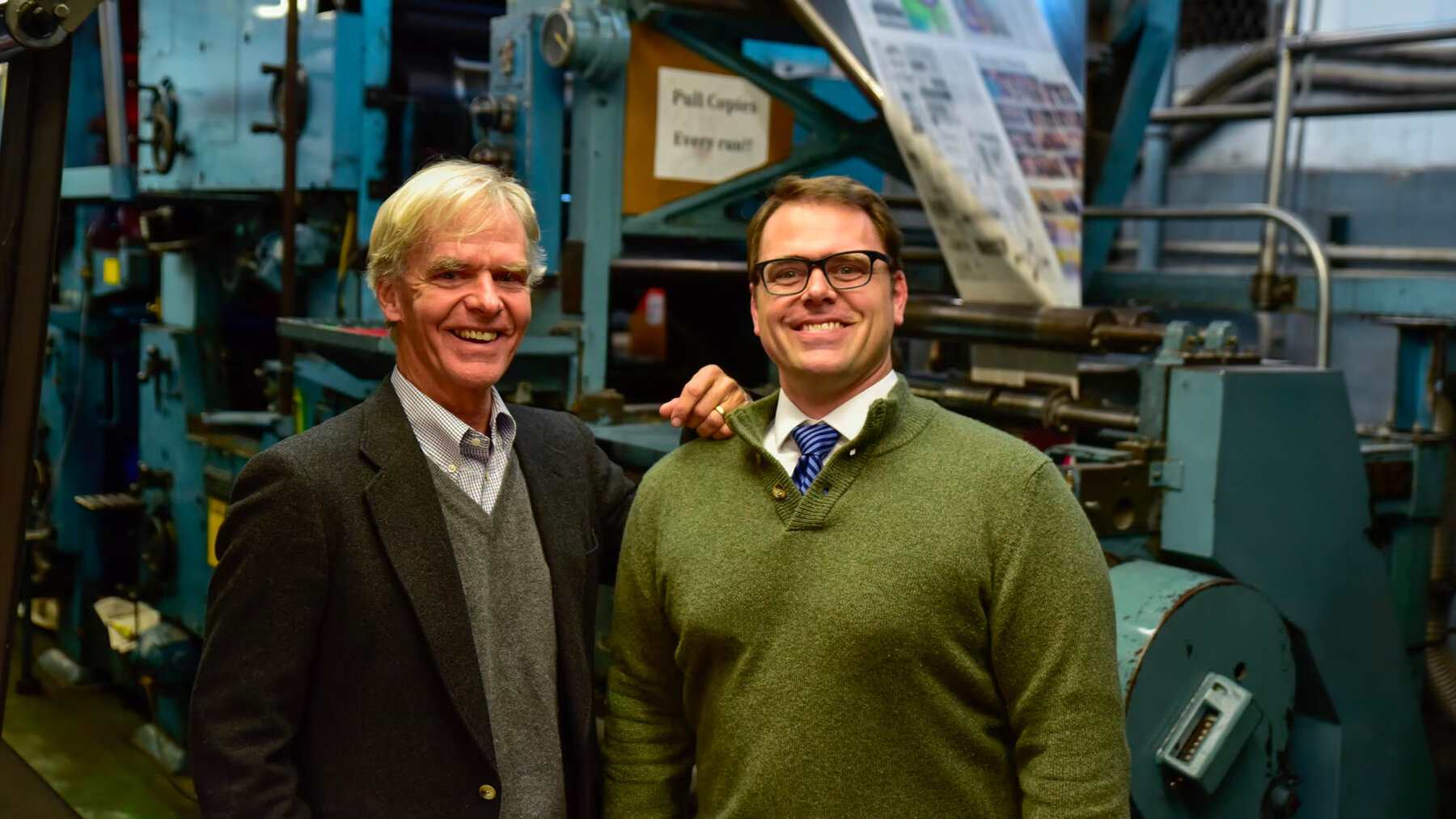As mentioned in the kickoff post in this new “Our Towns” series, anyone who cares about America’s civic, cultural, and economic future should care about the fate of the local press.
Journalism everywhere is coping with a variety of well-known stresses. The pressure to adapt, while there could still be time to survive, is especially intense on smaller, local outlets that may be the only source of community-wide information and accountability in their locale.
- For a sobering account of how severe this pressure has been for smaller publications, see this infographic from The Wall Street Journal.For a useful Q&A about a “solutions journalism” approach to making newspapers more compelling and relevant, see this NationSwell discussion with David Bornstein of the Solutions Journalism Network.For a look at future leaders of journalism, see the young women and men who make up this year’s Report for America corps of young reporters, who will work at local and regional papers. The 61 members in the 2019 corps represent a severalfold increase from the previous year.For a discussion of philanthropic guidelines in supporting local journalism, see this from the American Press Institute.For an ongoing account of how newspapers from California to Kansas have tried to use transparency and civic engagement to strengthen their role in the community (and their business base), see reports on the News Co/Lab site, including this from Dan Gillmor.
And for a report on how and why one small daily newspaper in the South has been bucking the national trend, read on about The Commercial Dispatch of Columbus, Mississippi.
Columbus is a town of about 24,000 in eastern Mississippi, which Deb Fallows and I have visited and written about frequently over the past five years. Its small downtown has architecturally beautiful “good bones,” of pre–World War II buildings now becoming popular for second- and third-story rentals and apartments.

One of the most stately of these downtown structures is the longtime home of the local daily newspaper, The Commercial Dispatch. The newspaper is nearly a century old; it has been based at its current home, on Main Street, since the 1920s; and through that period it has been owned and published by members of the Imes family.

The paper is printed each day in that same downtown site. Like other small-town, local papers, it is in worse shape than it was a decade ago. Then, its daily paid circulation was around 16,000. Now it’s between 13,000 and 14,000 (including a new edition for the nearby, prospering university town of Starkville, home of Mississippi State).
But it has held up much better than most. According to its publisher, Peter Imes—the fourth generation of the Imes family to have this role—the paper’s editorial staff is about the same as it was a decade ago: a total of 12. That is down from its historic peak of around 20, but has held steady in a time when newsroom staffs have been drastically hollowed out elsewhere. I’ve bought and read each day’s paper this week, and I’ve noticed that the front pages have featured local news, from on-staff reporters, rather than Associated Press or other syndicated stories.

How has the Dispatch held on, to the extent that it has? I spoke this week with Peter Imes, who last year succeeded his father, Birney Imes III, as publisher of the paper. The senior Imes, a renowned photographer, had taken over from his father in 1996.
Peter Imes, who is now 40, had not intended to continue in the family newspaper business. He grew up in Columbus but went off to work in software in Austin and then in historic-building renovation in Memphis. But when he and his wife had children, they considered returning to Columbus. He did some projects for the paper and found himself intrigued. “One day I sat in on a news-budget meeting, and it kind of drew me in,” Imes told me in Columbus this week. “Just seeing the process, seeing how ideas for stories kind of came into being, was absorbing.” He ended up working in various business, design, and editorial departments of the paper through his 30s.
“And then, frankly, the challenge of making this a successful business is attractive to me. It is a challenge. This once was a business that just printed money. Now you’ve got to work at it. And to me, that’s a lot more interesting.”
Imes stressed that nothing is secure or guaranteed about his paper’s survival. “All of us in the business have this fear that the bottom is just going to drop out at any minute.” But when we talked, three themes came through in his explanation of how the paper has survived so far.
News, over social media. “I always hesitate to say this, because it goes against convention—and I’m lucky enough to have a managing editor who agrees with me on this. But we really downplay social media. We don’t value it a lot. I think it’s a distraction.
“Of course it can be used to help promote the journalism we do. And it can sometimes be used to find good sources. But we’ve found that to be fairly rare. I think a lot of journalists right now spend too much time kind of establishing their personal brand on social media and not enough time actually talking to people in the community.”
Cost-consciousness. “We’re militant about expenses. Sometimes I flip through other newspapers and I go multiple pages without seeing any ads at all. I just don’t see how those papers are making any money.
“We are strict: If we don’t have the ads to support extra pages in the paper, we’re reducing the size of that day’s paper. It doesn’t matter how much content we have—if we don’t have the ads to support it, we don’t print those pages right now. We’ll refer people to the web for online versions of those stories.”
Having the right owners. The Dispatch is the last family-owned daily in Mississippi. From Citizen Kane and Chinatown onward, family ownership has historically meant that publications can play favorites, push pet causes, and generally confuse personal causes with civic ones. But in this moment of newspaper crisis, family ownership has had two related advantages for the Dispatch.
One of them—“definitely non-sexy,” as Imes put it—is that decades ago, his grandfather Birney Imes Jr. invested some of the paper’s profits in local self-storage sites and other buildings in the area. The paper still owns those properties, and their profits support its news operations. “Over the past 10 years, I’ve seen a lot of newspapers divest themselves of real estate and other assets,” Peter Imes said. “Instead, we have expanded, and that has provided a cushion for us in rough months.” He said that by the end of this year, non-newspaper assets might contribute 15 percent of the paper’s total budget.
The other advantage was the rest of the family’s agreement that these side revenues should, in fact, be used to keep the paper viable. “We all sat down last year to make sure we are on the same page,” he said. “We all see this as an important job we are doing for the community, and we’re comfortable having these extra funds funnel into the Dispatch.” Imes said that the family never seriously considered selling out to a newspaper chain or a venture-capital fund like the notorious Digital First Media, which has taken over small papers and dismantled their news staffs to maximize profit levels.
“I love the service a newspaper can be in its community,” Imes said in a Dispatch story announcing his appointment as publisher. “A local newspaper is the written legacy of a community, and the fact that my family’s history is so intertwined in that legacy is humbling. But the idea of where this paper—and this community— can go is invigorating.”
Is this a solution most other papers can follow—especially the last part, “Choose the right owners”? Probably not. But the search for solutions to the era’s local-journalism crisis will mean considering every success story for possible implications. And Imes’s emphasis on the make-or-break importance of an independent-ownership structure is resonant beyond the world of journalism, in this new era of monopoly and conglomeration. I’ll buy another copy of the Dispatch today.




